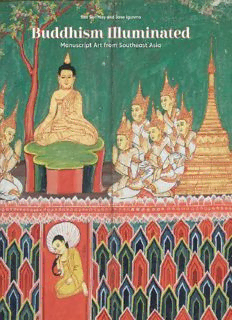
Buddhism Illuminated: Manuscript Art from South-East Asia PDF
Preview Buddhism Illuminated: Manuscript Art from South-East Asia
Buddhism Illuminated The Buddha in meditation posture, or dhyana mudra, illustrated in an artists’ manual. Folding book from central Thailand, nineteeth century. British Library, Or 14229, f.1 San San May and Jana Igunma Buddhism Illuminated Manuscript Art from Southeast Asia University of Washington Press Seattle In memory of Henry David Ginsburg Published in the United States of America by University of Washington Press www.washington.edu/uwpress ISBN 9780295743783 Text copyright © San San May and Jana Igunma 2018 Images copyright © The British Library Board 2018 Designed by Maggi Smith, Sixism Printed in Hong Kong by Great Wall Printing Co. All images are from the collection of the British Library unless stated otherwise in the captions. Note on transliteration and names Buddhist terms are spelled in their Pali form. Many Pali terms used in the study of Buddhism in Southeast Asia have now entered the English language or are generally well-known. Conventional spellings have thus been retained in this book, for example for Dhamma and Sangha. Since there are no universally accepted standards for the Romanisation of Southeast Asian alphabets, we followed the standards of the Library of Congress, also used in the British Library’s catalogues. However, we faced the dilemma that many less familiar Pali terms are spelled differently in different Southeast Asian languages, subsequently leading to confusion about diacritics in the Romanised form. For this reason we have decided to abandon the diacritics used in the Library of Congress Romanisation standards. Our hope is that this makes the book easier for the general reader to read while still enabling the scholarly reader to identify the term in its original form. Generally we have retained the best known geographical names in the region. We have used the name Thailand and the adjective Thai to refer to the country generally throughout history, although for limited periods of time Siam was the official name of the country and parts of other countries. For Myanmar we have used the name Burma and the adjective Burmese to refer generally to the country throughout its history. Contents Preface 1 CHAPTER Introduction 2 CHAPTER Buddha – The Enlightened One 3 CHAPTER Dhamma – The Righteous Way 4 CHAPTER Sangha – The Monastic Community 5 CHAPTER Kamma – Cause and Effect 6 CHAPTER Punna – Making Merit in Everyday Life 1 APPENDIX List of the 28 Buddhas of the past 2 APPENDIX Symbols on the Buddha’s footprint 3 APPENDIX Overview of the Tipitaka GLOSSARY BIBLIOGRAPHY INDEX Preface The British Library holds some of the finest collections of Southeast Asian manuscripts in the world. Buddhism is the focus of a large number of manuscripts from mainland Southeast Asia, many with magnificent illustrations. One former curator at the British Library who dedicated four decades of his life to the research of Buddhist manuscript art and literature was Dr Henry David Ginsburg; it is his outstanding contribution to the study of Southeast Asian manuscripts that we wish to honour with this book. His legacy facilitated our research and made the compilation of this book possible, and we are pleased and honoured to offer this publication to the general public and the scholarly community. We hope that it will further the study of Southeast Asian manuscripts and contribute to a better understanding of Buddhist art and culture in Southeast Asia. It has been a privilege to explore the work of skilled and visionary artists whose wonderful manuscript illustrations, like magic windows, allow us to look back in time. Due to the nature of the British Library’s manuscript collections, the focus of this book is on manuscripts from the Burmese (Myanmar) and Thai traditions. However, this does not mean that the manuscripts from other Southeast Asian cultures are less valuable or important. Wherever possible, we have tried to include a particularly fine example of the Shan, Lao and Cambodian traditions. Publication of this book has been made possible by the Ginsburg Legacy, presented to the British Library following the untimely death of Henry D. Ginsburg (1940–2007). We would like to express our gratitude to Titi Halle, Executor of the Estate of Henry D. Ginsburg, for all her support. We are also greatly indebted to our colleagues at the British Library, including Annabel Teh Gallop, Robert Davies, Sud Chonchirdsin and Lydia Seager, for their tireless support and encouragement. We would also like sincerely to thank photographers Elizabeth Hunter, Antony Grant and Alex White, who often made the impossible possible in terms of manuscript digitisation. We are especially grateful to our copy editor Catherine Bradley and designer Maggi Smith for their indispensable support in the production process of this book. Their meticulous professionalism is greatly appreciated. Others who lent their invaluable advice were Yohei Shimizu, Maria Kekki and Justin McDaniel. We never had the chance adequately to thank Toshiya
Description: